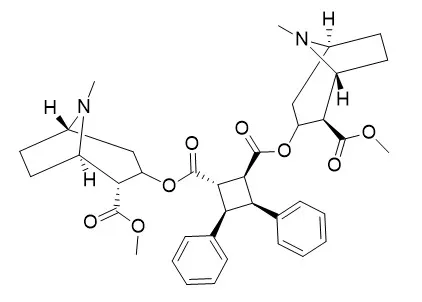| Structure Identification: |
| J Chromatogr A. 2014 Oct 17;1364:234-40. | | Rapid determination of the isomeric truxillines in illicit cocaine via capillary gas chromatography/flame ionization detection and their use and implication in the determination of cocaine origin and trafficking routes[Pubmed: 25219521 ] | The isomeric truxillines are a group of minor alkaloids present in all illicit cocaine samples. The relative amount of truxillines in cocaine is indicative of the variety of coca used for cocaine processing, and thus, is useful in source determination.
METHODS AND RESULTS:
Previously, the determination of isomeric truxillines in cocaine was performed with a gas chromatography/electron capture detection method. However, due to the tedious sample preparation as well as the expense and maintenance required of electron capture detectors, the protocol was converted to a gas chromatography/flame-ionization detection method. Ten truxilline isomers [alpha -truxilline(a-Truxilline ), beta -truxilline, delta -truxilline, epsilon -truxilline, gamma -truxilline(γ-Truxilline), omega- truxilline, zeta -truxilline, peri -truxilline, neo-Truxilline, and epi -truxilline] were quantified relative to a structurally related internal standard, 4′,4″-dimethyl-α-truxillic acid dimethyl ester. The method was shown to have a linear response from 0.001 to 1.00mg/mL and a lower detection limit of 0.001mg/mL.
CONCLUSIONS:
In this method, the truxillines are directly reduced with lithium aluminum hydride and then acylated with heptafluorobutyric anhydride prior to analysis.
The analysis of more than 100 cocaine hydrochloride samples is presented and compared to data obtained by the previous methodology. Authentic cocaine samples obtained from the source countries of Colombia, Bolivia, and Peru were also analyzed, and comparative data on more than 23,000 samples analyzed over the past 10 years with the previous methodology is presented. |
|






 Cell. 2018 Jan 11;172(1-2):249-261.e12. doi: 10.1016/j.cell.2017.12.019.IF=36.216(2019)
Cell. 2018 Jan 11;172(1-2):249-261.e12. doi: 10.1016/j.cell.2017.12.019.IF=36.216(2019) Cell Metab. 2020 Mar 3;31(3):534-548.e5. doi: 10.1016/j.cmet.2020.01.002.IF=22.415(2019)
Cell Metab. 2020 Mar 3;31(3):534-548.e5. doi: 10.1016/j.cmet.2020.01.002.IF=22.415(2019) Mol Cell. 2017 Nov 16;68(4):673-685.e6. doi: 10.1016/j.molcel.2017.10.022.IF=14.548(2019)
Mol Cell. 2017 Nov 16;68(4):673-685.e6. doi: 10.1016/j.molcel.2017.10.022.IF=14.548(2019)